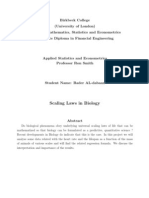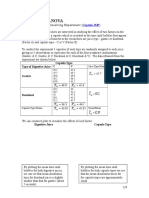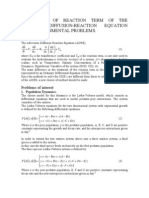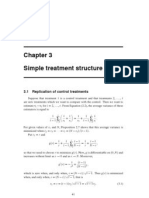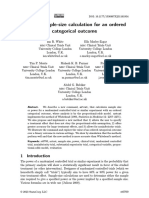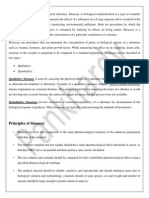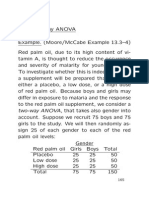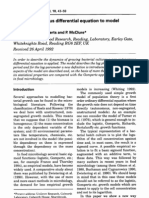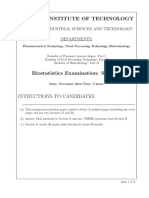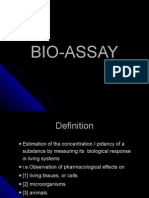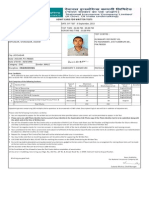Design and Analysis For Bioassays: Design Workshop Lecture Notes ISI, Kolkata, November, 25-29, 2002, Pp. 61-76
Design and Analysis For Bioassays: Design Workshop Lecture Notes ISI, Kolkata, November, 25-29, 2002, Pp. 61-76
Uploaded by
Mondeep PaulCopyright:
Available Formats
Design and Analysis For Bioassays: Design Workshop Lecture Notes ISI, Kolkata, November, 25-29, 2002, Pp. 61-76
Design and Analysis For Bioassays: Design Workshop Lecture Notes ISI, Kolkata, November, 25-29, 2002, Pp. 61-76
Uploaded by
Mondeep PaulOriginal Title
Copyright
Available Formats
Share this document
Did you find this document useful?
Is this content inappropriate?
Copyright:
Available Formats
Design and Analysis For Bioassays: Design Workshop Lecture Notes ISI, Kolkata, November, 25-29, 2002, Pp. 61-76
Design and Analysis For Bioassays: Design Workshop Lecture Notes ISI, Kolkata, November, 25-29, 2002, Pp. 61-76
Uploaded by
Mondeep PaulCopyright:
Available Formats
Design Workshop Lecture Notes
ISI, Kolkata, November, 25-29, 2002, pp. 61-76
Design and Analysis for Bioassays
G. M. Saha
Theoretical Statistics and Mathematics Unit, Indian Statistical Institute
Kolkata, India
1 Introduction
1. Purpose of biological assay
Biological assays are methods for the estimation of nature, constitution, or potency of
a material (or of a process) by means of the reaction that follows its application to living
matter.
(I) (II)
Qualitative Assays Quantitative Assays
These do not present any statistical These provide numerical assessment of
problems. We shall not some property of the material to be
consider them here. assayed, and pose statistical problems.
Denition. An assay is a form of biological experiment; but the interest lies in comparing
the potencies of treatments on an agreed scale, instead of in comparing the magnitude of
eects of dierent treatments.
This makes assay dierent from varietal trials with plants and feeding trials with ani-
mals, or clinical trials with human beings. The experimental technique may be the same,
but the dierence in purpose will aect the optimal design and the statistical analysis.
Thus, an investigation into the eects of dierent samples of insulin on the blood sugar of
rabbits is not necessarily a biological assay; it becomes one if the experimenters interest
lies not simply in the changes in blood sugar, but in their use for the estimation of the
potencies of the samples on a scale of standard units of insulin. Again, a eld trial of the
responses of potatoes to various phospatic fertilizers would not generally be regarded as
an assay; nevertheless, if the yields of potatoes are to be used in assessing the potency of
a natural rock phosphate relative to a standard superphosphate, and perhaps even in es-
timating the availability of phosphorus in the rock phosphate, the experiment is an assay
within the terms of the description given herein.
2. History of biological assay.
In the Bible, in the description of Noahs experiment from his ark by sending a dove
repeatedly until it returns with an olive leaf, by which Noah knows or estimates the level
of receding waters from the Earths grounds, we nd that it has all the three essential
constituents of an assay namely stimulus (depth of water), subject (the done) and
response (plucking of an olive leaf).
62 G. M. Saha [November
Serious scientic history of biological assay began at the close of 19th century with
Ehrlichs investigations into the standardization of diphtheria antitoxin. Since then, the
standardization of materials by means of the reactions of living matter has become a
common practice, not only in pharmacology, but in other branches of science also, such
as plant pathology. However the assays were put on sound bases only since 1930s when
some statisticians contributed with their rened methods to this area.
3. Structure of a Biological Assay
The typical bioassay involves a stimulus (for example, a vitamin, a drug, a fungicide),
applied to a subject (for example, an animal, a piece of animal tissue, a plant, a bacte-
rial culture). The intesity of the stimulus is varied by using the various doses by the
experimenter. Application of stimulus is followed by a change in some measurable char-
acteristic of the subject, the magnitude of the change being dependent upon the dose. A
measurement of this characteristic, for example, a weight of the whole subject, or of some
particular organ, an analytical value such as blood sugar content or bone ash percentage,
or even a simple record of occurrence or non-occurrence of a certain muscular contraction,
recovery from symptones of a dietary deciency, or death is the response of the subject.
4. Types of Bioassays
Three main types (other than qualitative assays)are :
(i) DIRECT ASSAYS;
(ii) INDIRECT ASSAYS based upon quantitative responses;
(iii) INDIRECT ASSAYS based on quantal responses (all-or-nothing).
5. Direct Assays
We shall rst take up DIRECT ASSAYS. In such assays doses of the standard and test
preparations are sucient to produce a specied response, and can be directly measured.
The ratio between these doses estimates the potency of test preparation relative to the
standard. If z
S
& z
T
are doses of standard & test preparations producing the same eect,
then the relative potency is given by
=
z
S
z
T
.
Thus, in such assays, the response must be clear-cut & easily recognized, and exact dose
can be measured without time lag or any other diculty.
A typical example of a direct assay is the cat method for the assay of digitalis.
Preparation is infused until its heart stops (causing death). The dose is immediately
measured.
2002] Design and Analysis for Bioassays 63
Preparations Tolerences mean
Strophanthus A 1.55, 1.58, 1.71, 1.44, 1.24, 1.89 1.68
(Test Prep.) 2.34
(in .01 cc/kg.)
Strophanthus B 2.42, 1.85, 2.00, 2.27, 1.70, 1.48, 1.99
(Stan. Prep.) : 2.20
(in .01 cc/kg.)
R = =
x
S
x
T
=
0.0199
0.0168
= 1.18 (Relative Potency Estimates)
Thus 1 cc of tincture A is estimated to be equivalent to 1.18 cc of tincture B.
Precision of the estimate ?
We shall work out the precision of our estimate. But before that, please note that in
the example considered, we have assumed that the two preparations contain the same
eective ingredient which proceduces the response. Such assays are called ANALYTICAL
DILUTION ASSAYS. We shall conne ourselves only to ADAs in this course. [An assay
with two preparations which have a common eect but do not contain the same eective
ingredient is called a COMPARATIVE DILUTION ASSAY.]
Let F = x
B
/x
A
Then
V (R) =
1
x
2
A
[V (x
B
) + R
2
V (x
A
)]
For tincture A,
(x x)
2
= 0.7587 & tincture B, = 0.6815. Both S.S. are based on 6 d.f.
Estimate of common variance s
2
=
0.7587+0.6815
12
= 0.1200.
V (x
A
) = V (x
B
) =
s
2
7
. Hence R = 1.18
& V (R) =
s
2
x
2
A
[
1
7
+
R
2
7
] = 0.0145.
So we have R = 1.18 0.120[
0.0145 = 0.120].
[Here we have used the result:
V [f(x, y)] = V (x)(
f
x
)
2
(E(x),E(y))
+ V (y)(
f
y
)
2
(E(x),E(y))
.
Thus
V (
a
b
) = V (a).
1
2
+ V (b)
4
, = E(a), = E(b)
=
1
2
[V (a) +
2
V (b)] where = /.]
We shall now try to give Fiducial limits for the estimate of relative potency using a
theorem, called FIELLERS THEOREM. This is due to Fieller (1940).
Let & be two parameters & = / respectively s.t. E(a) = & E(b) = . Also
let m = a/b be an estimate of . We shall assume that a & b are normally distributed
and that
64 G. M. Saha [November
V (a) = v
11
s
2
, V (b) = v
22
s
2
, cov(a, b) = v
12
s
2
where s
2
is an unbiased estimator for common variance
2
based on f d.f..
FIELLERS THEOREM. Upper & lower ducial limits of are :
m
L
, m
U
= [m
gv
12
v
22
+
t
0
s
b
{v
11
2mv
12
+ m
2
v
22
g(v
11
v
2
12
v
22
)}
1/2
]/(1 g)
where g = t
2
0
s
2
v
22
/b
2
, where t
0
is the two-sided percentage point of Students t distri-
bution with f d.f.
Proof. Consider the linear comb. (a b).
E(a b) = 0 & V (a b) = s
2
(v
11
2v
12
+
2
v
22
).
So, P[(a b)
2
t
2
0
s
2
(v
11
2v
12
+
2
v
22
)] = 1
The expression inside [ ] is expanded as an inequality for a quadratic expression in .
Thus, the event inside [ ] is equivalent to the following :
a
2
2ab +
2
b
2
t
2
0
s
2
(v
11
2v
12
+
2
v
22
) 0
i.e.,
2
(b
2
t
2
s
2
v
22
) + 2(t
2
0
s
2
v
12
ab) + (a
2
t
2
0
s
2
v
11
) 0.
[Now recall that px
2
+qx+r 0 r
1
x r
2
where r
1
r
2
are the two roofs of the
quadratic equation px
2
+qx +r = 0 and p > 0, since px
2
+qx +r = p(x r
2
)(x r
2
) = 0
becomes the equation. If p < 0, then it is equivalent to x r
1
x r
2
.]
So, we nd the two roots of the above Q.E. in :
(t
2
0
s
2
v
12
ab)
_
(t
2
0
s
2
v
12
ab)
2
(b
2
t
2
0
s
2
v
22
)(a
2
t
2
0
s
2
v
11
)
(b
2
t
2
0
s
2
v
22
)
Dividing both num
r
& denom
r
by b
2
, we get :
m
gv
12
v
22
_
(
t
2
0
s
2
v
12
b
2
m)
2
(1 g)(m
2
t
2
0
s
2
v
11
b
2
)
1 g
The term under square root (
) is :
g
2
v
2
12
v
2
22
2mgv
12
v
22
+ g
v
11
v
22
+ gm
2
g
2
v
11
v
22
= (
g
v
22
[v
11
2mv
12
+ v
22
m
2
gv
11
+ g
v
2
12
v
22
]
&
g
v
22
=
t
2
0
s
2
b
2
. Hence the result.
2002] Design and Analysis for Bioassays 65
6. Fiducial limits for the strophanthus assay.
If the tolerances of individual cats are assumed to be normally distributed with constant
variance, Fiellers theorem is directly applicable to the calculation of ducial limits for the
potency of tincture A relative to tincture B. We have :
s
2
v
11
= s
2
v
22
=
0.1200
7
, v
12
= 0. Hence
g =
(2.18)
2
0.1200
(1.68)
2
7
= 0.0289, a value small enough to be practically negligible. So, the
limits are :
R
L
, R
U
= [1.18
2.18
1.68
{
0.1200
7
(0.9711 + 1.18
2
)
1/2
]/0.9711] = 0.95, 1.48.
So, we can say that 1 cc of A may be asserted to have a potency lying between 0.95 cc
and 1.48 cc of B.
The purpose of a bioassay is to discover equally eective doses of the standard and
test preparations, that is to say, doses whose inverse ratio will estimate the potency of the
test preparation relative to the standard. One objection to the direct procedure discussed
earlier, is bias produced by time-lag. Even when this danger is absent, technical diculties
may prevent the experimenter from ensuring that subjects receive just the right dose to
produce the characteristic response : to determine individual toleences of cats for digitalis
may require no more than reasonable skill and care, but to determine individual tolerances
of aphids for an insecticide is impossible, and a dierent method of assay must be sought.
This leads us to INDIRECT ASSAYS. We shall rst discuss such assays with quantitative
responses (and not quantal).
2 Indirect Bio-Assays
In indirect bio-assays the relationship between the dose and response of each preparation
is rst ascertained. Then the dose corresponding to a given response is obtained from the
relation for each preparation separately. Consider two drugs, A and B, each administered
at k( 2) prexed levels (doses) d
1
, . . . , d
k
. Let Y
Si
and Y
Ti
be the response variables
for the standard and test preparations, respectively. It is not necessary to have the same
doses for both preparations, but the modications are rather straightforward, and hence
we assume this congruence. We assume rst that both Y
Si
and Y
Ti
are continuous (and
possibly nonnegative) random variables. Suppose, further, that there exist some dosage
x
i
= (d
i
), i = 1, . . . , k, and response-metameter Y
= g(X), for some strictly monotone
g(), such that the two dosage-response regressions may be taken as linear, namely that
Y
Ti
=
T
+
T
x
ti
+ e
Ti
,
Y
Si
=
S
+
S
x
si
+ e
Si
, i = 1, . . . , k, (2.1)
where, for statistical inferential purposes, certain distributional assumptions are needed
for the error components e
Ti
and e
Si
, i = 1, . . . , k. Generally, in the context of log dose
transformations we have a parallel -line assay, while slope-ratio assays arise typically for
power transformations.
When x
i
= log(dose) is the linearizing transformation, let for i = 1, . . . , k
E(Y
Si
) =
S
+ x
si
(2.2)
66 G. M. Saha [November
denote the relation between the expected response and x
s
where x
s
= log(d
s
) and d
s
denotes the dose of the standard preparation. Denoting by d
t
a dose equipotent to d
s
, we
have = d
s
/d
t
that is
log = log d
s
log d
t
= x
s
x
t
.
That is, x
s
= log + x
t
. Substituting for x
s
in the relation of the standard preparation
(2.2) , we get the relation for the test preparation as
E(Y
Si
) =
S
+ (log + x
ti
)
that is E(Y
Si
) =
T
+ x
ti
= E(Y
Ti
) (2.3)
where
T
=
S
+ log . Hence, the relationship for the test preparation is also linear
like that of the standard preparation for the same transformation. An examination of the
two equations for the two preparations shows that the lines have the same slope and are,
therefore, parallel.
Thus, in a parallel-line assay, the two dose-response regression lines (2.1) are taken to
be parallel and, further, that the errors e
Ti
and e
Si
have the same distribution (often taken
as normal). In this setup we then have
S
=
T
= (unknown), while
T
=
S
+ log ,
where is the relative potency of the test preparation with respect to the standard one.
This leads to the basic estimating function
log = {
T
S
}/, (2.4)
so that if the natural parameters ,
S
, and
T
are estimated from the acquired bioassay
dataset, statistical inferences on log (and hence ) can be drawn in a standard fashion.
If in an assay k doses are taken for each of the two preparations and x
s
and x
t
denote
the averages of the dose metameters and y
s
and y
t
are the average responses for the
preparations, then it is known that
S
= y
s
x
s
and
T
= y
t
x
t
. (2.5)
Substituting these values in log = {
T
S
}/, we get an estimate R of from
log R = x
s
x
t
{ y
s
y
t
}/. (2.6)
From equations (2.2) and (2.3) it is seen that the two lines for the two preparations
should be parallel when the dose metameter is log(dose). The assays corresponding to
this transformation are, therefore, called parallel line assays.
For normally distributed errors, the whole set of observations pertains to a conven-
tional linear model with a constraint on the two slopes,
S
and
T
, so that the classical
maximum likelihood estimators and allied likelihood ratio tests can be incorporated for
drawing statistical conclusion on the relative potency or the fundamental assumption of
parallelism of the two regression lines. However, the estimator of log involves the ratio
of two normally distributed statistics, and hence it may not be unbiased; moreover, gen-
erally the classical Fiellers theorem (see Finney, 1964) is incorporated for constructing
a condence interval for log (and hence, ). Because of this dierence in setups (with
that of the classical linear model), design aspects for such parallel-line assays need a more
careful appraisal. For equispaced (log), doses, a symmetric 2k-point design has optimal
information contents, and is more popularly used in practice. We refer to Finney(1964)
for a detailed study of such bioassay designs in a conventional normally distributed errors
model. Two main sources of nonrobustness of such conventional inference procedures are
the following:
2002] Design and Analysis for Bioassays 67
1. Possible nonlinearity of the two regression lines (they may be parallel but yet curvi-
linear).
2. Possible nonnormality of the error distributions.
On either count the classical normal theory procedures may perform quite nonrobustly,
and their (asymptotic) optimality properties may not hold even for minor departures from
either postulation. However, if the two dose-response repressions (linear or not) are not
parallel, then the fundamental assumption of parallel-line assays is vitiated, and hence
statistical conclusions based on the assumed model may not be very precise.
In a slope-ratio assay, the intercepts
S
and
T
are taken to be the same, while the
slopes
S
and
T
need not be the same and their ratio provides the specication of the
relative potency . In such slope-ratio assays, generally a power transformation: dosage
= (dose)
, for some > 0, is used, and we have
= {
T
/
S
}
1/
, (2.7)
which is typically a nonlinear function of the two slopes
T
and
S
, and presumes knowl-
edge of . In such a case the two error components may not have the same distribution
even if they are normal. This results in a heteroscedastic linear model (unless = 1),
where the conventional linear estimators or allied tests may no longer possess validity
and eciency properties. Moreover, because
is a ratio of two slopes, its conventional
estimator based on the usual estimators of the two slopes is of the ratio type. For such
ratio-type estimators, again the well-known Fieller theorem is usually adopted to attach
a condence set to or to test a suitable null hypothesis. Such statistical procedures may
not have the exact properties for small to moderate sample sizes. Even for large sample
sizes, they are usually highly nonrobust for departures from the model-based assumptions
(i.e. linearily of regressions, the fundamental assumption, and normality of the errors).
Again the design aspects for such slope-ratio assays need careful study, and Finney(1964)
contains a detailed account of this study. Because of the common intercept, usually a
2k + 1 point design, for some nonnegative integer k, is advocated here.
3 Parallel Line Assays
A parallel line assay in which each of the preparations has an equal number of doses and
an equal number of subjects is allotted to each of the doses, is called a symmetrical parallel
line assay. We shall discuss here only symmetrical parallel line assays.
Let the number of doses of each of the preparations be k. As there are in all 2k doses in
this assay, it is called a 2k-point symmetrical parallel line assay or simply 2k-point assay.
Let n subjects be allotted to each of the doses and a suitable response be measured
from each subject. Suppose further that s
1
, s
2
, . . . , s
k
denote the doses of the standard
preparation and t
1
, t
2
, . . . , t
k
the same for the test preparation. Denoting the response of
the rth subject allotted to the pth dose of the standard preparation by y
spr
and the rth
response from the qth subject of the test preparation by y
tqr
, the response data are rst
arranged as in Table 1.
68 G. M. Saha [November
TABLE 1
Response Data from 2k-Point Assay
Standard preparation Test preparation
Response Doses Doses
s
1
s
2
s
k
t
1
t
2
t
k
y
s11
y
s21
y
sk1
y
t11
y
t21
y
tk1
y
s12
y
s22
y
sk2
y
t12
y
t22
y
tk2
y
s1n
y
s2n
y
skn
y
t1n
y
t2n
y
tkn
Total S
1
S
2
S
k
T
1
T
2
T
k
The analysis of the assay for conducting validity tests and for estimating relative potency
becomes very much simplied when the doses of each of the preparations are taken in
geometric progression as shown below:
s, cs, c
2
s, . . . , c
k1
s and t, ct, c
2
t, . . . , c
k1
t
where s and t are suitable starting doses of the standard and test preparation respectively
and c is a constant which is the same for both the preparations. A further precaution
necessary while choosing the doses is that the doses should be evenly distributed in the
range of response in which the dose response relationship was investigated for obtaining
the linearizing transformation.
Let
x
s
i
= log c
i
s = log s + i log c (i = 0, 1, 2, . . . , k 1)
and
x
t
i
= log c
i
t = log t + i log c (i = 0, 1, 2, . . . , k 1).
Denoting by x
s
and x
t
the averages of the doses of the two preparations, we get
x
s
= log s +
k 1
2
log c (3.1)
and
x
t
= log t +
k 1
2
log c (3.2)
So,
x
s
i
x
s
=
_
i
k 1
2
_
log c
and
x
t
i
x
t
=
_
i
k 1
2
_
log c.
Case 1 When k is odd we choose the base of the logarithm as c so that log c is 1. The log
dose as deviates from their mean can now be written as below:
Standard preparation
k 1
2
,
k 3
2
, . . . , 1, 0, 1, . . . ,
k 1
2
Test preparation
k 1
2
,
k 3
2
, . . . , 1, 0, 1, . . . ,
k 1
2
2002] Design and Analysis for Bioassays 69
By choosing the base of the logarithm as above, these deviate values could be made
integers.
Case 2 When k is even, the base of the logarithm is taken as
c so that log c becomes 2
and hence all the dose deviates (i (k 1)/2) log c become odd integers as shown below.
Standard preparation
(k 1), (k 3), . . . , 1, 1, 3, . . . , (k 1)
Test preparation
(k 1), (k 3), . . . , 1, 1, 3, . . . , (k 1)
The regression contrast for each preparation can now be obtained by multiplying these
deviate values by the coresponding dose totals and adding them.
Analysis
As stated earlier the purpose of analysis of indirect bio-assays is two fold. First, it is
tested through the analysis of variance technique if, (i) the dose metameter and response
relationship is linear and (ii) the two lines for the two preparations are parallel. If the tests
reveal that the relationship is linear and the lines are parallel, then the relative potency
of the test preparation is estimated from the relation
log R = x
s
x
t
y
s
y
t
b
We have already obtained x
s
and x
t
at (3.1) and (3.2), y
s
y
t
is given by
y
s
y
t
=
i
S
i
i
T
i
kn
The combined regression coecient of the two preparations as obtained at (3.3) below
gives the value of b.
For the rst part of the analysis the following contrasts among the dose totals are
obtained.
Preparation contrast:
(L
p
) =
i
S
i
+
i
T
i
(3.3)
Combined regression contrast:
(L
1
) =
k 1
2
(S
1
+ T
1
)
k 3
2
(S
2
+ T
2
) +
k 1
2
(S
k
+ T
k
)
when k is odd.
Combined regression contrast
(L
1
) = (k 1)(S
1
+ T
1
) (k 3)(S
2
+ T
2
) + (k 1)(S
k
+ T
k
)
when k is even.
The dierence between the two regression contrasts of the two preparations is the
parallelism contrast.
Parallelism contrast
(L
1
) =
k 1
2
(S
1
T
1
)
k 3
2
(S
2
T
2
) +
k 1
2
(S
k
T
k
)
70 G. M. Saha [November
when k is odd.
= (k 1)(S
1
T
1
) (k 3)(S
2
T
2
) + (k 1)(S
k
T
k
)
when k is even.
It is seen that y
s
y
t
=
L
p
kn
.
Again, when k is odd
b =
L
1
4
_
_
k1
2
_
2
+
_
k3
2
_
2
+ + 1
2
_
=
6L
1
kn(k
2
1)
.
When k is even
b =
L
1
4{(k 1)
2
+ (k 3)
2
+ + 1
2
}
=
3L
1
2kn(k
2
1)
.
The following analysis of variance table is then written for the validity tests and estimation
of error variance.
TABLE 2
Analysis of Variance in 2k-point Assays for Validity Tests
Sources of variation d.f. s.s. m.s. F
Preparation (L
p
) 1 L
2
p
/2kn
Regression (combined) (L
1
) 1 L
2
1
/D
Prallelism (L
1
) 1 L
2
1
/D s
2
b
s
2
b
/s
2
Deviation from regression 2k 4 By subtraction s
2
d
s
2
d
/s
2
Doses 2k 1
i
S
2
i
+
i
T
2
i
n
{
(S
i
+T
i
)}
2
2kn
Within doses (error) 2k(n 1) By subtraction s
2
Total 2kn 1
pr
y
2
spr
+
qr
y
2
tqr
(S
i
+T
i
)}
2
2kn
The value of D, the divisor for the regression and the parallelism sums of squares in
the above table is (kn(k
2
1))/6 when k is odd and (2kn(k
2
1))/3 when k is even.
For testing the linearity of regression, the mean squares for the deviations from regres-
sion is tested by the F-test using the within mean squares as error. For testing parallelism,
the parallelism component is tested.
If both these tests are not signicant, then the relative potency can be estimated as
below.
log R = x
s
x
t
y
s
y
t
b
= log s log t +
L
p
kn
kn(k
2
1)
6L
1
when k is odd
= log
s
t
+
(k
2
1)
6
L
p
L
1
or
R =
s
t
antilog
_
d(k
2
1)
6
L
p
L
1
_
2002] Design and Analysis for Bioassays 71
where d = log
10
c.
When k is even
log R = log
s
t
+
L
p
kn
2kn(k
2
1)
3L
1
.
That is
R =
s
t
antilog
_
d(k
2
1)
3
L
p
L
1
_
.
Precision of R can be estimated through Fiellers theorem.
4 Block Designs for Parallel Line Assays
The use of incomplete block designs in bio-assays is limited mainly by the inexibility of
existing incomplete block designs, including the balanced incomplete block (BIB) designs.
These designs aim at estimating the dierences between all pairs of treatments with the
same (or nearly the same) variance. But in bio-assays all contrasts are not of equal
importance, especially in symmetrical parallel line and slope-ratio assays, in which two
particular contrasts are of major importance. These contrasts for parallel line assays are:-
(i) the dierence between the totals of the standard and test preparations (the prepa-
ration contrast)
(ii) the pooled estimate of slope (the combined regression contrast).
In symmetrical parallel line assays the numbers of doses of the two preparations (stan-
dard and unknown, or test) are the same, doses are equispaced logarithmically, and re-
sponse depends linearly on log dose. Let s
1
, s
2
, . . . , s
k
denote k doses (on the logarith-
mic scale) of the standard preparation arranged in ascending order of magnitude, and
t
1
, t
2
, . . . , t
k
denote the k doses of the test preparation arranged in descending order of
magnitude: the (constant) dierence between successive log-doses is the same for both
series. (The doses of the two preparations are ordered in opposite directions for notaional
convenience.) Further, let S
i
, T
i
denote the totals of the observations (or responses) for
the doses s
i
, t
i
respectively. For a design in complete blocks of 2k subjects, Finney (1964)
denes contrasts of these total appropriate for estimating the relative potency of the test
preparation and for testing validity (i.e. for verifying the assumptions underlying the
method of estimation of relative potency). The rst contrast, called the preparation or
material contrast, is
L
p
=
k
i=1
(T
i
S
i
).
The second is the combined slope or regression contrast, denoted by L
1
, and is the sum of
the linear contrasts of the dose totals of the two preparations. The two contrasts L
p
and
L
1
are necessary for estimating the relative potency. The other contrasts provide validity
tests: they are the parallelism contrasts, denoted by L
1
(the dierence between the two
linear contrasts), L
2
and L
2
(the sum and dierence of the quadratic contrasts of the dose
totals of the two preparations) and further pairs of contrasts of the type L
m
and L
m
(sums
and dierences of mth power contrasts among dose totals of the two preparations).
When an incomplete block design is used for such an assay, the blocks (litters, cages,
etc.) are no longer orthogonal to the doses, and some at least of the dened contrasts of
the dose total are not free from block eects. Dose eects must therefore rst be estimated
72 G. M. Saha [November
by the methods appropriate to the design, and used in place of unadjusted dose totals to
calculate the contrasts.
We describe rst the method of construction of a series of incomplete block designs for
symmetrical parallel line assays from which the preparation contrast L
p
and combined
slope contrast L
1
can be obtained from unadjusted dose totals, as in the case of ordinary
complete block designs.
Any incomplete block design for the k doses of the standard preparation in blocks of
size k
(k
< k) is taken. The nal design is then obtained by including k
doses of the test
preparation in each block of the previous design, using the rule that if the dose s
i
of the
standard preparation occurs in the block, then the dose t
i
should also be included. (We
recall that the t
i
are numbered in descending order of magnitude of dose.) We thus have
an incomplete block bio-assay design, in 2k
units per block, from which preparation and
combined slope contrasts can be obtained from unadjusted dose totals. This is evident
from the following considerations. The preparation contrast is independent of block eects
because equal numbers of doses of the two preparations occur in each block of the design.
Also, since the dose totals S
i
and T
i
have the same coecient, but with opposite signs, in
the combined slope contrast (as can be easily veried by referring to tables of orthogonal
polynomials- (see Das and Giri, 1986), this contrast can be expressed as a weighted total of
within-block contrasts, and so is free from block eects. For the same reason, all relevant
contrasts of the types L
2n+1
and L
2n+2
can be estimated from unadjusted dose totals. Such
contrasts are estimated with full accuracy, and are, clearly, at least as precisely estimated
by the incomplete block design as they would be by a complete block design; they will be
more precise if the reduction in block size reduces variance. The other contrasts L
2n+1
and
L
2n+2
are aected by block dierences, and must be estimated by the method appropriate
to the design.
These designs are in fact equivalent to singular group divisible partially balanced in-
complete block designs- (see Dey, 1986).
If the original design involving k doses of the standard preparation is a BIB design,
all the estimated contrasts are uncorrelated. If the original design is any other incomplete
block design, such as the cyclic design, estimates of those contrasts (L
2n+1
and L
2n+2
)
which are aected by block dierences are correlated among themselves.
As an example, consider the construction of a 6-point parallel line assay design in
blocks of 4.
The three blocks of a BIB design with 3(= k) standard doses as treatments, with
2(= k
) doses in each block are
s
1
s
2
; s
1
s
3
; s
2
s
3
. (4.1)
The assay design is constructed by adding to these blocks the corresponding doses of the
test preparation:
Block 1) s
1
s
2
t
1
t
2
2) s
1
s
3
t
1
t
3
3) s
2
s
3
t
2
t
3
.
The coecients of the contrasts required in this assay are shown in Table 3 (again, we
recall that s
1
< s
2
< s
3
and t
1
> t
2
> t
3
).
2002] Design and Analysis for Bioassays 73
TABLE 3
Contrasts for 6-point Parallel Line Assay
log dose
s
1
s
2
s
3
t
1
t
2
t
3
L
p
-1 -1 -1 1 1 1
L
1
-1 0 1 1 0 -1
L
1
-1 0 1 -1 0 1
L
2
1 -2 1 1 -2 1
L
2
1 -2 1 -1 2 -1
It is easily veried that the preparation (L
p
) the combined slope (L
1
) and the between-
quadratic (L
2
) contrasts so estimated from unadjusted dose totals are free from block
eects.
A design of particular interest is that in which any block contains only two doses, s
i
and t
i
. There will thus be k blocks each with two doses: all the contrasts L
p
, L
2n+1
and
L
2n+2
are estimable free from block eects, while the rest of the contrasts are completely
confounded with blocks. This design must be replicated several times for estimation of
error.
BIB designs can be used conveniently up to 6-point assays. For 8 or more points,
BIB designs require more replicates than are usually convenient in assays. The number of
replicates required can be considerably reduced by basing block contents on cyclic designs
(See Das and Giri, 1986): a design for a 2k-point assay in blocks of 4 units, obtained from
a circular design of block size 2, is
s
1
s
2
t
1
t
2
; s
2
s
3
t
2
t
3
; ; s
k
s
1
t
k
t
1
.
These blocks may be repeated several times to ensure enough degrees of freedom for error.
5 Analysis for Parallel Line Assays Based on BIB De-
signs
The analysis of parallel line assays consists essentially of two parts. The rst part is the
computation of the analysis of variance, including sums of squares due to the various
contrasts dened earlier, and providing validity tests and the error mean square. The
other part consists of estimating the relative potency and its variance, and limits.
The sum of squares for any contrast unaected by block dierences is calculated by
_
k
i=1
l
i
S
i
i=1
l
i
T
i
_
2
_
r(2
k
i=1
l
2
i
) (5.1)
where l
1
, l
2
, . . . are coecients of the contrast and r is the number of observations (or
replicates) on which S
i
or T
i
is based. The s.s. due to the other contrasts are calculated
from least squares estimates s
1
, s
2
, . . . , s
k
and t
1
, t
2
, . . . , t
k
of the eects of the various
doses of the standard and test preparations (we use the same symbols for the doses and
their estimated eects, since there is no danger of confusion), using the model
y
mj
= +
j
+
m
+ e
mj
(5.2)
where y
mj
is the response to dose m in the jth block, is the general mean and
j
the
jth block eect,
m
denotes s
m
or t
m
as may be appropriate, and the error e
mj
is assumed
74 G. M. Saha [November
to be normally distributed with zero mean and variance,
2
. The desired contrasts are
then calculated from the estimated dose eects, and the corresponding s.s. obtained as
indicated by earlier. The error s.s. is found in general as the dierence between the total
s.s. and (unadjusted block s.s. + adjusted dose s.s.). When estimates of all contrasts are
uncorrelated, as for BIB designs, the adjusted dose s.s. can be obtained from the model
of the s.s. due to all the contrasts. The details of the analysis for designs based on BIB
designs follow.
Adjusted dose totals are
Q
S
i
= S
i
j(i)
y
j
Q
T
i
= T
i
j(i)
y
j
(5.3)
where y
j
(j = 1, 2, . . . , b) is the jth block average, and summation is over allblocks con-
taining dose i of the preparations. All the required contrasts are functions of these Qs.
Those unaected by block dierences are functions of the dierences Q
s
i
Q
T
i
(= S
i
T
i
):
sums of squares due to them are most conveniently obtained, as described earlier, directly
from the dose totals. The remaining contrasts are functions of
Q
i
= Q
S
i
+ Q
T
i
: (5.4)
the s.s. due to any aected contrasts,
k
i=1
l
i
Q
i
, is then
[
k
i=1
l
i
Q
i
]
2
/rE(2
k
i=1
l
2
i
) (5.5)
where
E = (rk
r + )/rk
,
k
being the block size of the starting design and the number of blocks in each of which
any two given doses of the standard preparation occur together.
The variance of the estimate of an aected contrast is
(2
i
l
2
i
/rE)
2
2k
,
where
2
2k
is the error variance in incomplete blocks of size 2k
. If a randomised (complete)
block design is used, the corresponding variance is (2
i
l
2
i
/r)
2
2k
, where
2
2k
denotes the
error variance in complete blocks of 2k units. If a BIB with 2k doses, blocks of size k
1
, and
r replications is used, the variance is (2
i
l
2
i
/rE
)
2
k
1
, where E
is the eciency factor
of this BIB design and
2
k
1
its error variance. Thus, the eciency of the present design
in respect of aected contrasts is E
2
2k
/
2
2k
when compared with the randomised block
design and (E/E
)(
2
k
1
/
2
2k
) when compared with the basic BIB design. Hence if the
reduction of variance is such that
2
2k
/
2
2k
< E the present series of bio-assay designs
will be more ecient than randomised blocks even for the aected contrasts. Comparison
with BIB designs with 2k doses is possible only for particular cases. But when the BIB
designs are used some information is lost on each contrast, and particularly on L
p
and
L
1
, the contrasts of major importance, which are estimated without loss by the designs
mentioned here.
2002] Design and Analysis for Bioassays 75
An Example
For illustrating the method of analysis of a 6-point symmetrical parallel line assay
Bliss(1952, p. 498) presented a body of data collected on a vitamin D assay by Coward and
Kassner(1941): the design used 12 litters of 6 rats as randomized blocks. Here we use these
data with some modications. To ensure comparability of the estimate of relative potency
all observations were used, but were tted into an incomplete block design of the present
series by omitting two observations from each of the original blocks (litters), as shown
by blanks in Table 4, and forming 6 additional blocks (13-18) from the 24 observations
omitted, ignoring litter dierences, but retaining the dose-observation relation. The design
assumed is that for 6 treatments in blocks of 4 derived in Section 4 from a BIB design:
the 3 blocks of the design were replicated 6 times, to accommodate the 72 observations of
the original assay. The data and the assumed design are shown in Table 4.
TABLE 4
Data and BIB design based Parallel Line Assay (Doses in mg.)
Standard Test
s
1
s
2
s
3
t
3
t
2
t
1
Block
Block number 2.5 5 10 2.5 5 10 total
1 2 8 - - 9 7 26
2 6 - 9 3 - 8 26
3 - 6 12 4 6 - 28
4 9 11 - - 14 13 47
5 10 - 17 8 - 10 45
6 - 7 5 6 9 - 27
7 4 10 - - 11 13 38
8 11 - 9 3 - 15 38
9 - 9 14 5 8 - 36
10 4 7 - - 10 10 31
11 12 - 9 15 - 15 51
12 - 8 11 7 8 - 34
13 4 4 - - 5 9 22
14 7 - 8 3 - 9 27
15 - 15 10 6 8 - 39
16 2 4 - - 6 6 18
17 4 - 13 5 - 12 34
18 - 10 13 4 18 - 45
Totals 75 99 130 69 112 127 612
S
1
S
2
S
3
T
3
T
2
T
1
Adjusted -25.75 1.25 22.50 -31.75 14.25 19.50 0
totals Q
S
1
Q
S
2
Q
S
3
Q
T
3
Q
T
2
Q
T
1
S.S. due to blocks = 358.00
TABLE 5
Contrasts, Divisors and Sums of Squares for Data of Table 4
Contrast Divisor Sum of squares
L
p
4 6 12 = 72 0.22
L
1
113 4 12 = 48 266.02
L
2
-35 12 12 = 144 8.51
L
1
-3.00 4 9 = 36 0.25
L
2
-46.50 12 9 = 108 20.02
Total 295.02
For this design, r = 12, k
= 2, and = 6, whence rE = (rk
r +)/k
= 9. Using the
contrast coecients of Table 3, and formulae (5.1), (5.4) and (5.5), contrasts, divisors, and
76 G. M. Saha [November
sums of squares are obtained as shown in Table 5 for unaected (L
p
, L
1
, L
2
) and aected
(L
1
, L
2
) contrasts: the analysis of variance is shown in Table 6.
As in the original analysis, all the validity tests are satised. Though the estimate
of relative potency must remain identical with the original estimate, the mean squares
due to error and the aected contrasts will be dierent. After regrouping the data there
are 49 d.f. for error, of which 10 d.f. may be contaminated by dierences between the
original litters. The mean square for the contaminated component is 6.11, while that for
the remaining 39 d.f. is 7.23: the error mean square in the original analysis was 7.22,
with 55 d.f. Thus grouping of observations on animals from dierent litters into the same
block has not increased the error mean square (as might have been expected from the
signicance of the between-block mean square).The estimate of the relative potency is
R =
2.5
2.5
antilog {
4d
3
.
L
p
L
1
} = antilog {
16d
339
} where d = log
10
2.
TABLE 6
Analysis of Variance of Data of Table 4
Nature of variation d.f. s.s. m.s. F
Between Blocks 17 358.00 21.06 3.01**
Preparations 1 0.22 0.22
Regression 1 266.02 266.02 38.00**
Prallelism 1 0.25 0.25 < 1
Comb. Quadratic 1 20.02 20.02 2.86NS
Di. quadratic 1 8.51 8.51 1.22NS
All Contrasts 5 295.02
Error (by substraction) 49 342.98 7.00
Total 71 996.00
References
Dey, A. (1986). Theory of Block Designs, Wiley, New Delhi.
Das, M.N. and Giri, N.C. (1986). Design and Analysis of Experiments, Wiley, New Delhi.
Finney, D.J. (1964). Statistical Methods in Biological Assay, 2nd ed. Grine, London.
You might also like
- LECTURE Notes On Design of ExperimentsDocument31 pagesLECTURE Notes On Design of Experimentsvignanaraj88% (8)
- 4 Bioassays PDFDocument17 pages4 Bioassays PDFDrAmit VermaNo ratings yet
- Lab 1 - Iodine ClockDocument13 pagesLab 1 - Iodine ClockHân LêNo ratings yet
- Use of Baseline Covariates in Cross Over Studies - Kenward2009Document18 pagesUse of Baseline Covariates in Cross Over Studies - Kenward2009Nilkanth ChapoleNo ratings yet
- BIOASSAYDocument16 pagesBIOASSAYFree Escort ServiceNo ratings yet
- Bioassay 5th SemDocument66 pagesBioassay 5th Semraj royel100% (10)
- Bader 2Document12 pagesBader 2tanmaypatilNo ratings yet
- Bioassays: Erna SulistyowatiDocument19 pagesBioassays: Erna SulistyowatiMuhammad Sukri JafarNo ratings yet
- Bioassays: Erna SulistyowatiDocument18 pagesBioassays: Erna SulistyowatibekthyNo ratings yet
- Research Paper - EdonDocument13 pagesResearch Paper - EdonEdon OntoNo ratings yet
- Entropy: Measures of Difference and Significance in The Era of Computer Simulations, Meta-Analysis, and Big DataDocument11 pagesEntropy: Measures of Difference and Significance in The Era of Computer Simulations, Meta-Analysis, and Big DataRicardo AravenaNo ratings yet
- Chapter12 Anova Analysis CovarianceDocument14 pagesChapter12 Anova Analysis CovariancemanopavanNo ratings yet
- Introduction To The Chemostat H.T. Banks and Marie DavidianDocument27 pagesIntroduction To The Chemostat H.T. Banks and Marie DavidianCristina CroitoruNo ratings yet
- STAT 700 Homework 5Document10 pagesSTAT 700 Homework 5ngyncloudNo ratings yet
- A Nova Sumner 2016Document23 pagesA Nova Sumner 2016Supun RandeniNo ratings yet
- Anova 1Document36 pagesAnova 1Abhishek Kumar SinghNo ratings yet
- Ch6-Comparisons of SeveralDocument43 pagesCh6-Comparisons of SeveralarakazajeandavidNo ratings yet
- AnnovaDocument19 pagesAnnovaLabiz Saroni Zida0% (1)
- TEST OF HYPOTHESESDocument25 pagesTEST OF HYPOTHESESamodafoluwakeNo ratings yet
- ANCOVADocument8 pagesANCOVAAbdulNo ratings yet
- 8 Inferential Statistics VIII - May 26 2014Document22 pages8 Inferential Statistics VIII - May 26 2014Bijay ThapaNo ratings yet
- Module 3 PDFDocument23 pagesModule 3 PDFSherwinEscanoNo ratings yet
- Bio 1020 Unit 1Document39 pagesBio 1020 Unit 1rbyq9No ratings yet
- RCBD Anova Notes (III)Document13 pagesRCBD Anova Notes (III)yagnasreeNo ratings yet
- Binomial Test For Non Parametric StatisticsDocument5 pagesBinomial Test For Non Parametric StatisticsJay SantosNo ratings yet
- Covariance Analysis: Rajender Parsad and V.K. Gupta I.A.S.R.I., Library Avenue, New Delhi - 110 012Document6 pagesCovariance Analysis: Rajender Parsad and V.K. Gupta I.A.S.R.I., Library Avenue, New Delhi - 110 012Héctor YendisNo ratings yet
- Is Anova A Star?: What Does ANOVA Mean?Document11 pagesIs Anova A Star?: What Does ANOVA Mean?meropeus10No ratings yet
- Tempelman Experimental - DesignDocument41 pagesTempelman Experimental - DesignMedardo Antonio Díaz CéspedesNo ratings yet
- BioassayDocument38 pagesBioassayMuhammad Masoom Akhtar100% (1)
- Chi - Square Test: PG Students: DR Amit Gujarathi DR Naresh GillDocument32 pagesChi - Square Test: PG Students: DR Amit Gujarathi DR Naresh GillNaresh GillNo ratings yet
- Lecture 3 Role of Statistics in ResearchDocument34 pagesLecture 3 Role of Statistics in ResearchFazlee KanNo ratings yet
- f - The function f is not completely known, but it is known up to a set of p, - . -, βDocument6 pagesf - The function f is not completely known, but it is known up to a set of p, - . -, βulirschjNo ratings yet
- Two-Way ANOVADocument9 pagesTwo-Way ANOVATakudzwa MamvutoNo ratings yet
- Modelling of Reaction Term of The Adr EquationDocument9 pagesModelling of Reaction Term of The Adr Equationricardogl1982No ratings yet
- Williams 1986 A Note On Shirleys Nonparametric Test For Comparing Several Dose Levels With A Zero-Dose ControlDocument5 pagesWilliams 1986 A Note On Shirleys Nonparametric Test For Comparing Several Dose Levels With A Zero-Dose ControlCarlos AndradeNo ratings yet
- Biostat - Group 3Document42 pagesBiostat - Group 3Jasmin JimenezNo ratings yet
- Analysis of Variance (Anova) : Estimate of The Population Variance From The Variance Within The SampleDocument3 pagesAnalysis of Variance (Anova) : Estimate of The Population Variance From The Variance Within The SampleSarath DevNo ratings yet
- Analisis Peranan Tanaman Herba Meniran Sebagai Antimalaria Terhadap Pertumbuhan PlasmodiumDocument9 pagesAnalisis Peranan Tanaman Herba Meniran Sebagai Antimalaria Terhadap Pertumbuhan PlasmodiumSyilvie_DeNo ratings yet
- Doe Web 3Document10 pagesDoe Web 3sandymylife221No ratings yet
- CH 35 Statistical TreatmentDocument28 pagesCH 35 Statistical Treatmentmebajar05No ratings yet
- Artcat: Sample-Size Calculation For An Ordered Categorical OutcomeDocument21 pagesArtcat: Sample-Size Calculation For An Ordered Categorical OutcomeSlava YurkovNo ratings yet
- Analysis of Variance Analysis of Variance: An ExampleDocument5 pagesAnalysis of Variance Analysis of Variance: An Examplesou.beraNo ratings yet
- BioassayDocument7 pagesBioassayashutosh kumar YadavNo ratings yet
- Mole Concept Type 1Document24 pagesMole Concept Type 1Sagar VermaNo ratings yet
- Principles of BioassayDocument17 pagesPrinciples of BioassayUmasankar KulandaiveluNo ratings yet
- 1 普物實驗數據的處理 (不確定度的更改)Document16 pages1 普物實驗數據的處理 (不確定度的更改)extracurricular8000No ratings yet
- 2 Way AnovaDocument20 pages2 Way Anovachawlavishnu100% (1)
- Baranyi Et Al 1993 A Non-Autonomous Differential Equation To Model Bacterial Growth PDFDocument17 pagesBaranyi Et Al 1993 A Non-Autonomous Differential Equation To Model Bacterial Growth PDFCarlos AndradeNo ratings yet
- Harare Institute of TechnologyDocument4 pagesHarare Institute of Technologyntando ndlovuNo ratings yet
- Lab 01Document8 pagesLab 01ozlemNo ratings yet
- Applied Biostatistics 2020 - 05 ANOVADocument44 pagesApplied Biostatistics 2020 - 05 ANOVAYuki NoShinkuNo ratings yet
- Incomplete Block DesignDocument5 pagesIncomplete Block DesignAby MathewNo ratings yet
- Modification of Tukey's Additivity Test: Petr Sime Cek, Marie Sime Ckov ADocument9 pagesModification of Tukey's Additivity Test: Petr Sime Cek, Marie Sime Ckov A53melmelNo ratings yet
- 9 - Introduction To Factorial Experiments Two-Way ANOVA: ExampleDocument11 pages9 - Introduction To Factorial Experiments Two-Way ANOVA: ExampleRonaldo ManaoatNo ratings yet
- Bio AssayDocument69 pagesBio AssayUttam Mukherjee100% (2)
- Efecto Olor en AbejasDocument11 pagesEfecto Olor en AbejasfabiandionisioNo ratings yet
- Biological Clocks, Rhythms, and Oscillations: The Theory of Biological TimekeepingFrom EverandBiological Clocks, Rhythms, and Oscillations: The Theory of Biological TimekeepingNo ratings yet
- A Dmit Ca RD For W Ritten Tests: Dear C AndidateDocument1 pageA Dmit Ca RD For W Ritten Tests: Dear C AndidateMondeep PaulNo ratings yet
- b896946693e34869a9a36b54c3c4a5d9Document2 pagesb896946693e34869a9a36b54c3c4a5d9Mondeep PaulNo ratings yet
- "Employment Generation and Poverty Alleviation in Developing Countries" Challenges and Opportunitiesspecial Reference To IndiaDocument6 pages"Employment Generation and Poverty Alleviation in Developing Countries" Challenges and Opportunitiesspecial Reference To IndiaMondeep PaulNo ratings yet
- Uttaranchal Gramin Bank Clerk Exam 2012 Solved Paper: General English (Exam Held On 12-2-2012)Document10 pagesUttaranchal Gramin Bank Clerk Exam 2012 Solved Paper: General English (Exam Held On 12-2-2012)Mondeep PaulNo ratings yet
- Adv Non-Faculty PositionDocument2 pagesAdv Non-Faculty PositionMondeep PaulNo ratings yet
- National Institute of Open SchoolingDocument6 pagesNational Institute of Open SchoolingMondeep PaulNo ratings yet







